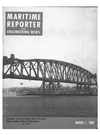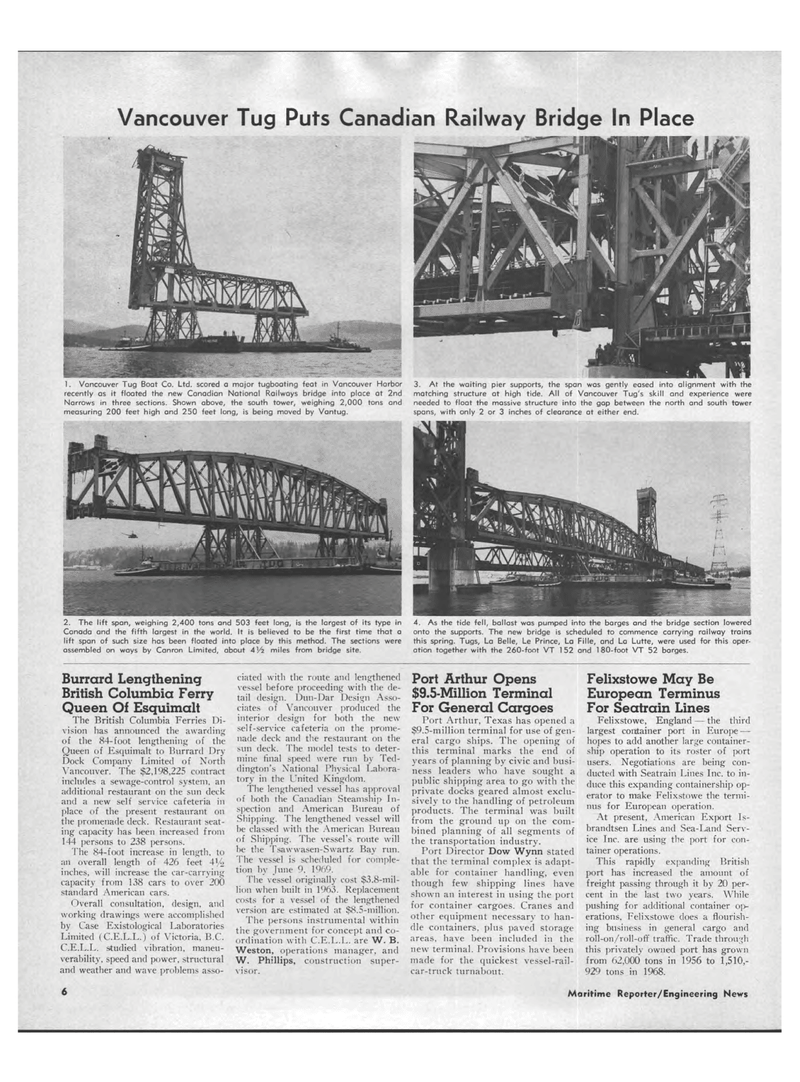
Page 4: of Maritime Reporter Magazine (March 1969)
Read this page in Pdf, Flash or Html5 edition of March 1969 Maritime Reporter Magazine
1. Vancouver Tug Boat Co. Ltd. scored a major tugboating feat in Vancouver Harbor recently as it floated the new Canadian National Railways bridge into place at 2nd Narrows in three sections. Shown above, the south tower, weighing 2,000 tons ond measuring 200 feet high and 250 feet long, is being moved by Vantug. 3. At the waiting pier supports, the span was gently eased into alignment with the matching structure at high tide. All of Vancouver Tug's skill and experience were needed to float the massive structure into the gap between the north and south tower spans, with only 2 or 3 inches of clearance at either end. Vancouver Tug Puts Canadian Railway Bridge In Place 2. The lift span, weighing 2,400 tons and 503 feet long, is the largest of its type in Canada and the fifth largest in the world. It is believed to be the first time that a lift span of such size has been floated into place by this method. The sections were assembled on ways by Canron Limited, about AVi miles from bridge site. 4. As the tide fell, ballast was pumped into the barges and the bridge section lowered onto the supports. The new bridge is scheduled to commence carrying railway trains this spring. Tugs, La Belle, Le Prince, La Fille, and La Lutte, were used for this oper-ation together with the 260-foot VT 152 and 180-foot VT 52 barges. Burrard Lengthening British Columbia Ferry Queen Of Esquimalt The British Columbia Ferries Di-vision has announced the awarding of the 84-foot lengthening of the Queen of Esquimalt to Burrard Dry Dock Company Limited of North Vancouver. The $2,198,225 contract includes a sewage-control system, an additional restaurant on the sun deck and a new self service cafeteria in place of the present restaurant on the promenade deck. Restaurant seat-ing capacity has been increased from 144 persons to 238 persons. The 84-foot increase in length, to an overall length of 426 feet 4% inches, will increase the car-carrying capacity from 138 cars to over 200 standard American cars. Overall consultation, design, and working drawings were accomplished by Case Existological Laboratories Limited (C.E.L.L.) of Victoria. B.C. C.E.L.L. studied vibration, maneu-verability, speed and power, structural and weather and wave problems asso-ciated with the route and lengthened vessel before proceeding with the de-tail design. Dun-Dar Design Asso-ciates of Vancouver produced the interior design for both the new self-service cafeteria on the prome-nade deck and the restaurant on the sun deck. The model tests to deter-mine final speed were run by Ted-dington's National Physical Labora-tory in the United Kingdom. The lengthened vessel has approval of both the Canadian Steamship In-spection and American Bureau of Shipping. The lengthened vessel will be classed with the American Bureau of Shipping. The vessel's route will be the Tsawwasen-Swartz Bay run. The vessel is scheduled for comple-tion by June 9. 1969. The vessel originally cost $3.8-mil-lion when built in 1963. Replacement costs for a vessel of the lengthened version are estimated at $8.5-million. The persons instrumental within the government for concept and co-ordination with C.E.L.L. are W. B. Weston, operations manager, and W. Phillips, construction super-visor. Port Arthur Opens $9.5-Million Terminal For General Cargoes Port Arthur, Texas has opened a $9.5-million terminal for use of gen-eral cargo ships. The opening of this terminal marks the end of years of planning by civic and busi-ness leaders who have sought a public shipping area to go with the private docks geared almost exclu-sively to the handling of petroleum products. The terminal was built from the ground up on the com-bined planning of all segments of the transportation industry. Port Director Dow Wynn stated that the terminal complex is adapt-able for container handling, even though few shipping lines have shown an interest in using the port for container cargoes. Cranes and other equipment necessary to han-dle containers, plus paved storage areas, have been included in the new terminal. Provisions have been made for the quickest vessel-rail-car-truck turnabout. Felixstowe May Be European Terminus For Seatrain Lines Felixstowe, England ? the third largest container port in Europe ? hopes to add another large container-ship operation to its roster of port users. Negotiations are being con-ducted with Seatrain Lines Inc. to in-duce this expanding containership op-erator to make Felixstowe the termi-nus for European operation. At present, American Export Is-brandtsen Lines and Sea-Land Serv-ice Inc. are using the port for con-tainer operations. This rapidly expanding British port has increased the amount of freight passing through it by 20 per-cent in the last two years. While pushing for additional container op-erations. Felixstowe does a flourish-ing business in general cargo and roll-on/roll-off traffic. Trade through this privately owned port has grown from 62,000 tons in 1956 to 1,510,-929 tons in 1968. 6 Maritime Reporter/Engineering News

 3
3

 5
5
